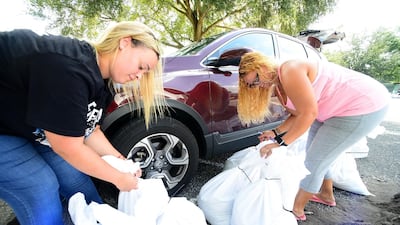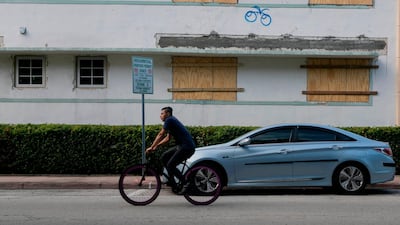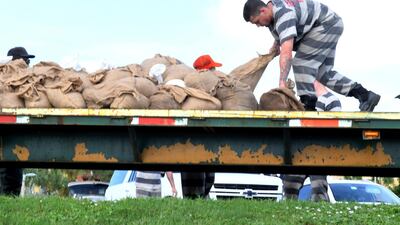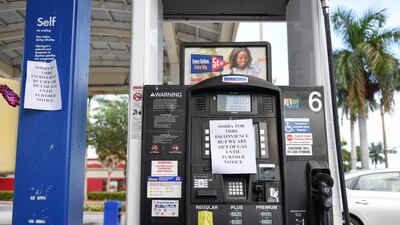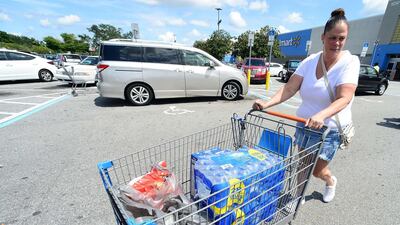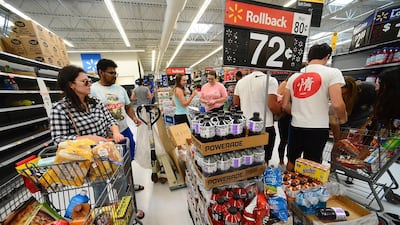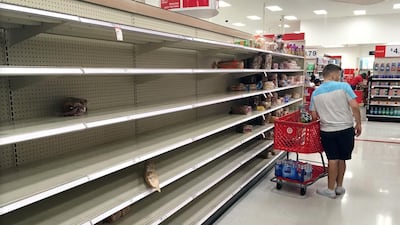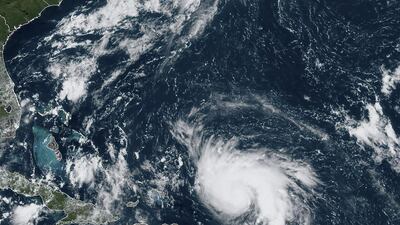Unsure where Hurricane Dorian is going to land over the Labour Day weekend in the United States, many Florida residents faced a sense of helplessness as they prepared for what President Donald Trump said could be an "absolute monster" of a storm.
"All indications are it's going to hit very hard and it's going to be very big," Mr Trump said in a video he tweeted Thursday evening, comparing Dorian to Hurricane Andrew, which devastated South Florida in 1992.
Mr Trump cancelled a trip to Poland on Sunday, saying it was "very important" to stay home to deal with coming storm.
The National Hurricane Centre said the Category 2 storm was expected to strengthen into a potentially catastrophic Category 4 with winds of 209 kph and slam into the US on Monday somewhere between the Florida Keys and southern Georgia — a 805-kilometre stretch that reflected the high degree of uncertainty this far out.
"If it makes landfall as a Category 3 or 4 hurricane, that's a big deal," said University of Miami hurricane researcher Brian McNoldy. "A lot of people are going to be affected. A lot of insurance claims."
With the storm's track still unclear, no immediate mass evacuations were ordered. Along Florida's east coast, local governments began distributing sandbags, shoppers rushed to stock up on food, plywood and other emergency supplies at supermarkets and hardware stores, and motorists filled up their tanks and storage cans. Some fuel shortages were reported in the Cape Canaveral area.
Josefine Larrauri, a retired translator, went to a Publix supermarket in Miami only to find empty shelves in the water section.
"I feel helpless because the whole coast is threatened," she said. "What's the use of going all the way to Georgia if it can land there?"
In Vero Beach, about 225km up the coast from Miami, Lauren Harvey, 51, scoured the aisles of a nearby supermarket in search for non-perishable food items that could last her through the storm.
Ms Harvey, who recently moved from the Philadelphia area, said she was not sure what to expect.
"I just moved here, so I'm lost," she said with a blank expression on her face, after grabbing a couple of water bottles from a scantly-stocked shelf. "I don't know what I'm going to do."
Tiffany Miranda of Miami Springs waited well over 30 minutes in line at BJ's Wholesale Club in Hialeah to buy hurricane supplies.
"You never know with these hurricanes. It could be good, it could be bad. You just have to be prepared," she said.
As of Thursday evening, Dorian was centred about 475km east of the Bahamas, its winds blowing at 169 kph as it moved north-west at 19 kph.
Mr McNoldy, the hurricane researcher, said it was expected to pick up steam as it entered warm waters with favourable winds. "Starting [Friday], it really has no obstacles left in its way."
The National Hurricane Centre's projected track had the storm blowing ashore midway along the Florida peninsula, south-east of Orlando and well north of Miami or Fort Lauderdale. But because of the difficulty of predicting its course this far ahead, the "cone of uncertainty" covered nearly the entire state.
Forecasters said coastal areas of America's south-east could get between 13 and 25 centimetres of rain, with 38cm in some places, triggering life-threatening flash floods.
Also under threat were the Bahamas, with Dorian's expected track running just to the north of Great Abaco and Grand Bahama islands.
Jeff Byard, an associate administrator at the Federal Emergency Management Agency, warned that Dorian was likely to "create a lot of havoc with infrastructure, power and roads", but gave assurances FEMA is prepared to handle it, even though the Trump administration is shifting hundreds of millions of dollars from FEMA and other agencies to deal with immigration at the Mexican border.
"This is going to be a big storm. We're prepared for a big response," Mr Byard said.
Florida Governor Ron DeSantis declared a state of emergency, clearing the way to bring in more fuel and call out the National Guard if necessary, and Georgia's governor followed suit.
Royal Caribbean, Carnival and Norwegian began rerouting their cruise ships. Major airlines began allowing travellers to change their reservations without a fee.
The hurricane season typically peaks between mid-August and late October. One of the most powerful storms ever to hit the US was on Labour Day in 1935. The unnamed category 5 hurricane crashed ashore along Florida's Gulf Coast on September 2. It was blamed for over 400 deaths.
Dorian rolled through the Virgin Islands and Puerto Rico as a Category 1 hurricane on Wednesday.
The initial blow did not appear to be as bad as expected in Puerto Rico, which is still recovering from the devastation wrought by Hurricane Maria two years ago.
But the tail end of the storm unleashed heavy flooding along the eastern and southern coasts of Puerto Rico. Cars and homes in the coastal town of Humacao were half submerged after a river burst its banks.
Dorian caused an island-wide blackout in St Thomas and St John in the US Virgin Islands and scattered outages in St Croix, government spokesman Richard Motta said.
